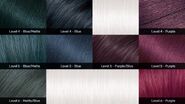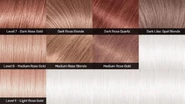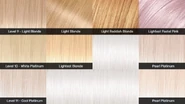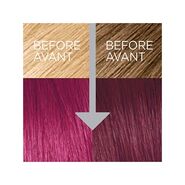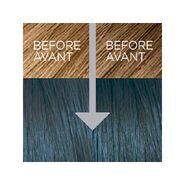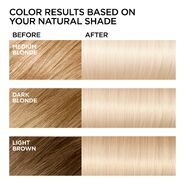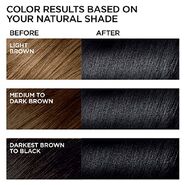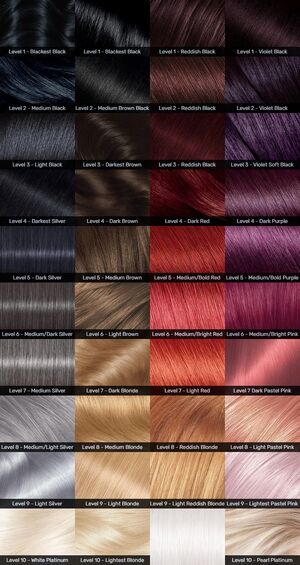
Levels for: Ash-Blue Tones, Neutral Tones, Red/Copper Tones and Purple (Violet)/Red-Violet Tones.
- Go here if you are looking for the category Hair Levels.
- Go here if you are looking for the article Coloured Hair.
- Go here if you are looking for Hair Tones.
Hair Depth or Hair Levels refers to "The International Hair Colour Level System" of 1 - 10, with 1 being the darkest (Black) and 10 being the lightest (Lightest Blonde) but occasionally 10+, 11 and 12 is used. These levels can determine how Hair Colouring will effect hair. Often the best results on colouring hair for bright colours and pastel colours are Levels 7-10. Dark vibrant colours tend to work best with Levels 4-5.
- Black, Pure or Blackest Black
- Medium Black or Natural Black
- Darkest Brown, Light or Soft Black (3.5 Darkest Brown)
- Dark Brown (4.5 Medium/Dark Brown)
- Medium Brown (5.5 Medium/Light Brown)
- Light Brown (6.5 Lightest Brown)
- Dark Blonde (7.5 Medium/Dark Blonde)
- Medium Blonde (8.5 Medium/Light Blonde)
- Light Blonde (9.5 Lightest Blonde)
- Lightest Blonde, White Blonde or Platinum
Reds
- 1-3. Reddish Black
- 3.5-4.5. Dark Red
- 5-6. Medium Red
- 6.5-7.5. Light Red
- 8. Reddish Blonde
- 9. Light Reddish Blonde
Keep in mind that when using professional hair dyes, they don't follow the same levels that drugstore brands do. A Level 6 light brown to you could be a Level 7 dark blonde to professionals. Black is still considered a Level 1 but Level 2 is considered darkest brown for professional hair dyes and the chart goes on from there.
Before you pick your shade be aware of your skin's undertone, keep your natural hair level in mind, the colour of your eyebrows and your age. Cool, warm and olive tones mostly should try to choose a shade with hair tones that compliments or you may not be getting the full effect you desire.
If you are jumping more than 4 levels make sure you have taken careful consideration, because it can make you look like a different person, and some cannot pull off jet black hair or platinum blonde easily. However, at times the high contrast may be the desired effect one is looking for and getting what you want is the ultimate goal.
Eyebrows may not be much of an issue but in some cases to pull off a drastic colour change you may want to consider lightening, darkening or colour matching them. It might not be much of a change if you simply get eyebrow mascara or use lighter or darker eyebrow makeup, however, some people also consider dying their brows to match their hair.
When it comes to age a shade can make you look older or younger, the older you get is when you may want to consider going lighter in hair level. This doesn't mean you have to give up colour to go grey either. Most people know what they are comfortable with, if they don't want to give up their darker hair—at least yet—adding highlights or a highlight chunk is sometimes done instead.
What is also helpful when choosing a shade is understanding hair levels when used by brands. Brands often use the level system when coding or naming their products. Used with or without letters or add additional numbers, example:
- Color Sensation Light Natural Blonde 9.0
- Olia Light Blonde 9.0
- Nutrisse Cream Light Natural Blonde 90
- Nutrisse Cream Natural Light Neutral Blonde 913
- Nutrisse Cream Very Light Beige Blonde 98
- Nutrisse Nourishing Color Creme Light Natural Blonde 90
- Superior Preference Light Ash Blonde 19
- Superior Preference Light Blonde 9
- Superior Preference Light Natural Blonde 9N
All of the above refers to Level 9, within each brands' own prerogative of coding, because in some cases brands may use a product code that may not follow the leveling number system or forgo using any product code at all.
Below is the list of hair levels, for convenience, have been detailed, broken down and explained. Underlying tones means the dominant pigment in the hair usually occurring naturally or from lifted hair and the corrective tones means the tones needed to neutralize these dominant tones. Example swatches have also been provided and put in 4 columns: Ash-Blue Tones, Neutral Tones, Red/Copper Tones and Purple (Violet)/Red-Violet Tones.
Note that for some bolder colourful shades with primary red or purple tones for example, tend to have a larger level spread compared to the black to blonde range. For example as show above Reddish Black is covered by Level 1, 2 and 3. So one brand or product line of a brand could have a shade coded for Level 2 but look like a Level 1 or a Level 3 could look like a Level 2. This could indicate a larger margin of error on codes for depth or intensity with bolder colours, so keep this in mind when selecting your shade.
Level 1[]
Black, Pure or Blackest Black. Reddish Black.
- Underlying Tone(s): Darkest Red-Brown (Blue)
- Corrective Tone(s): Orange (Copper)
Level 1 is the darkest level of hair color—dark black. Black shades are either Level 1, Level 2, or Level 3, and Level 1 is the darkest sometimes referred as jet or ink black. Level 1 is primarily unnatural—even people whose natural hair colors are black do not naturally have Level 1 black hair (refer to the chart of hair color levels).
Level 1 hair color is usually found in blue black hair colors or "ultimate" black hair colors. It is best suited for people whose natural hair color is from Level 2 to Level 3. While Level 1 color often has neutral or no undertones, the overall effect is usually "cool" as opposed to neutral or warm.
Level 1 has also has been used to represent "bold coloured black shades" and is arguably no different than Level 2 and some Level 3 dark bold shades. For example the 4th shade in the example below is actually coded as Level 2 but seems closer to Level 1. Level 1 and 2 is most common in ash, blue and neutral tones and less common—but still found—in red, red-violet and purple tones.
Level 2[]
Medium Black or Natural Black. Reddish Black.
- Underlying Tone(s): Dark Red-Brown (Blue-Violet)
- Corrective Tone(s): Yellow-Orange (Golden)
Level 2 is the second darkest hair color level. It is usually used to describe a natural black, and is the natural color of most people who have naturally black hair along with Level 3, soft/light black hair (refer to the chart of hair color levels). Most drugstore black hair shades are Level 2, medium black. Level 2 hair color is best suited to people whose natural hair color is between Level 2 and Level 3.5.
Level 2 has also has been used to represent "darkest bold shades" and is arguably no different than Level 1 and some Level 3 bold shades. However, Level 2 and Level 3 dark bold shades are more commonly found compared to Level 1.
Level 3[]
Darkest Brown, Light or Soft Black. Reddish Black.
- Underlying Tone(s): Dark Red-Brown/Red-Brown (Violet)
- Corrective Tone(s): Yellow (Beige)
Level 3 is the third darkest hair color depth. It is used to mean soft or light black hair. Often people whose natural hair color is black either have Level 2 or Level 3 hair (refer to the chart of hair color levels). Sometimes Level 3 hair color can also be very dark red, sometimes referred to as burgundy black, rich black, or reddish black.
Level 3 has also has been used to represent "darker bold shades" and is arguably no different than Level 2 and Level 1 bold shades. However, Level 2 and Level 3 dark bold shades are more commonly found compared to Level 1.
Level 3.5[]
Darkest Brown. Dark Red Level 3.5 is the hair color in between black and brown—darkest brown. It is not a common color to see in box dyes, but it does occur sometimes. Level 3.5 is also a very common natural hair color, often misrepresented as "black".
Level 4[]
Dark Brown. Dark Red.
- Underlying Tone(s): Red (Red-Violet)
- Corrective Tone(s): Yellow-Green (Matte)
Level 4 is the hair color level that is represented as "dark brown". It is one of the most common natural hair colors and also very commonly found in hair dye. This brunette depth can also run into unwanted red tones but this can be neutralized with a corrective green or matte tone or neutralizing colour depositing product.
Level 4 is also common in red or burgundy shades and is usually referred to as "dark red", "mahogany" or "burgundy". Level 4 is an easy hair level to pull off—it suits everyone with natural hair colors Level 2 to Level 6.
Level 4 has also has been used to represent "darkest silver shades" and "dark bold shades".
Level 4.5[]
Medium/Dark Brown. Dark Red
Level 4.5 is medium to dark brown hair. It is a common natural hair color, but not commonly found on box dyes. However, when it is, it is usually in the form of a dark red shade, or referred to as "dark soft brown" or "soft dark brown". Level 4.5 hair color can be flattering on anyone with a natural shade from Level 2 to Level 6.5.
Level 5[]
Medium Brown. Medium Red.
- Underlying Tone(s): Red (Red)
- Corrective Tone(s): Green (Matte)
Level 5 is a term for medium brown but can also refer to the medium-bold red shades. It is one of the most common natural color levels in the world, but also commonly shows up in box dyes. Level 5 hair can be flattering on anyone with a natural hair color from Level 2 to Level 7. This brunette depth can also run into unwanted red tones but this can be neutralized with a corrective green or matte tone or neutralizing colour depositing product.
Level 7 has also has been used to represent some "bold shades".
Level 5.5[]
Medium/Light Brown. Medium Red.
Level 5.5 is a term for medium-light brown hair. It is a common natural color but not as common in box dyes, like many other half shades. Level 5.5 hair can be flattering on anyone with a natural hair color from Level 2 to Level 7.5.
Level 6[]
Light Brown. Medium Red.
- Underlying Tone(s): Orange (Red-Orange)
- Corrective Tone(s): Blue-Green (Ash)
Level 6 is another term for light brown hair. It is quite common in box dyes. This brunette depth can also run into unwanted red tones/copper tones but this can be neutralized with a corrective green/blue tone or neutralizing colour depositing product.
Level 6 hair can also refer to the brighter shades of medium red hair. Most medium auburn shades are Level 5 or Level 6. Level 6 can be flattering on anyone with the natural hair color from Level 3 to Level 9.
Level 6 has also has been used to represent " light or medium bright shades".
Level 6.5[]
Lightest Brown. Light Red.
Level 6.5 is a term for lightest brown hair, and it can also be used to refer to some shades of auburn/red. This is not a common natural hair color, nor is it common on the drugstore shelves. Level 6.5 is a great hair color for blondes desiring to go brunette, but not go too dark. It can be flattering on anyone whose natural hair color is from Level 4 to Level 9.
Level 7[]
Dark Blonde. Light Red.
- Underlying Tone(s): Gold-Orange (Orange)
- Corrective Tone(s): Blue (Cool Ash/Blue)
Level 7 is a term used for dark blonde hair, but it can also refer to some bright or light auburns/reds. It is common to find Level 7 shades in hair dye. Level 7 hair can be flattering on people whose natural hair color is from Level 4 to Level 10. This blonde depth can also run into unwanted copper tones but this can be neutralized with a corrective blue tone or neutralizing colour depositing product.
Level 7 has also has been used to represent some "bright shades" and "medium dark pastel shades".
Level 8[]
Medium Blonde. Reddish Blonde.
- Underlying Tone(s): Gold (Yellow-Orange)
- Corrective Tone(s): Blue-Violet (Blue)
Level 8 refers to medium blonde hair. This is a common depth found in hair dyes but not very common for natural hair color. This blonde depth can also run into unwanted copper/yellow tones but this can be neutralized with a corrective blue/purple tone or neutralizing colour depositing product.
Level 8 hair can also refer to light reds/strawberry blondes. Level 8 hair can be flattering on anyone whose natural hair color is from Level 6 to Level 10.
Level 8 has also has been used to represent "soft or smoky silver shades" and some "pastel shades". It is starting to be more commonly found in hair dyes.
Level 8.5[]
Medium/Light Blonde. Reddish Blonde.
Level 8.5 is a hair color level which refers to hair that is between medium and light blonde. This can also refer to very light red shades, like strawberry blonde. Level 8.5 can be flattering on people whose natural hair color is from Level 6 to Level 10.
Level 9[]
Light Blonde. Light Reddish Blonde.
- Underlying Tone(s): Yellow (Yellow)
- Corrective Tone(s): Violet (Purple)
Level 9 refers to light blonde hair and rarely but occasionally it can refer to the lightest strawberry blonde shades. Level 9 is hair is extremely rare as a natural hair color, but common as a hair dye shade. This blonde depth can also run into unwanted yellow tones but this can be neutralized with a corrective purple tone or neutralizing colour depositing product.
In some cases Level 9 and Level 10 light/lightest blondes show little to no difference, so be sure to consider both Level 9 and 10 blonde shades, if you are looking for light or lightest blondes. It can be flattering on anyone whose natural hair color is from Level 6.5 to Level 10.
Level 9 has also has been used to represent "light silver" and "lightest pastel shades". It is starting to be more commonly found in hair dyes.
Level 9.5[]
Lightest Blonde.
Level 9.5 refers to very light blonde hair. This is a very uncommon natural color but occurs sometimes in hair dye shades. Level 9.5 can be flattering on anyone with a natural hair color from Level 7 to Level 10.
Level 10[]
Lightest Blonde, White Blonde or Platinum.
- Underlying Tone(s): Pale Yellow (Yellow)
- Corrective Tone(s): Violet (Purple)
Level 10 refers to the lightest possible blonde hair color. This hair color is almost never found naturally but is relatively common in hair dye, and can be achieved with bleach, but that can be damaging and take a while. In some cases Level 9 and Level 10 light/lightest blondes show little to no difference, so be sure to consider Level 9-10 blonde shades, if you are looking for light or lightest blondes. This blonde depth can also run into unwanted yellow tones but this can be neutralized with a corrective purple tone or neutralizing colour depositing product.
Level 10 has also has been used to represent "lightest silver shades". It is starting to be more commonly found in hair dyes. But is still mostly reserved for lightest blonde and platinum blonde shades. Note the example below has "White Platinum", "Lightest Blonde", a blank and "Pearl Platinum", the blank would represent a brassy Level 10 which most would correct with dye, toner or colour depositing products. A brassy Level 10 is not common nor really a wanted product, so no helpful swatches were available but it is a common bleaching result.
Level 10+[]
Level 10+, 11 or 12 refers to white blonde, ultra-light blonde or Platinum is known as Level 10+ but is often umbrellaed under Level 10 and Level 10+, 11 or 12 is used for marketing purposes.
This hair color is never found naturally unless in some cases of albinism, matured white or grey-white hair but is fairly popular in hair dye, and can be achieved with bleach, toners, color depositing shampoos, conditioners and/or masks. This can be damaging, costly and very high maintenance.
Often brands have their own in-house charts and guides when using their products and the Wiki has provided some cross-brand examples. Here are some examples:













